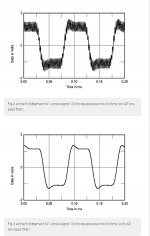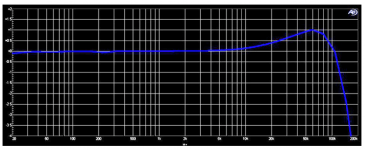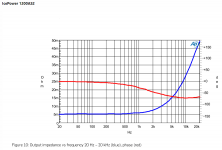Icebrick IcePower Engine-400
https://icepower.dk/products/amplifier-power-modules/icebricks/


XTZ - EDGE A2-400
XTZ - EDGE A2-400 - Electronics

https://icepower.dk/products/amplifier-power-modules/icebricks/
XTZ - EDGE A2-400
XTZ - EDGE A2-400 - Electronics
"-3 dB at 100 kHz giving very low phase shift at 20 kHz."
If that's what the low order switching noise output filter is doing.
I'd hate to see what kind of switching noise is on the 10khz square wave from the output of this amp, bet it looks like a buzz-saw with no resemblance to a 10k square wave. Probably much worse than this top pic.
Cheers George
If that's what the low order switching noise output filter is doing.
I'd hate to see what kind of switching noise is on the 10khz square wave from the output of this amp, bet it looks like a buzz-saw with no resemblance to a 10k square wave. Probably much worse than this top pic.
Cheers George
Attachments
If you saw a linear amp with this on it's square wave you' say it was broken, you get over it.
I've seen still working but "blued" Wilson tweeter voice coils because of this over time as he used to leave them on, I changed the diagram's for the customer with original new ones and they sounded great again, no need to tell you he flicked those D monoblocks that got "good" reviews on Stereophile, and went back to linear. And no the D's had no dc on the output or anything weird save for the switching noise oscillation
I've seen still working but "blued" Wilson tweeter voice coils because of this over time as he used to leave them on, I changed the diagram's for the customer with original new ones and they sounded great again, no need to tell you he flicked those D monoblocks that got "good" reviews on Stereophile, and went back to linear. And no the D's had no dc on the output or anything weird save for the switching noise oscillation
Last edited:
Yes, a linear amp with such an RF residual is broken (or being forced to drive a not so wisely chosen load). But that is a different story and doesn't mean that class-d amps are defective from the beginning.
The RF residual shown in your second last post would have a power of 15 Miliwatts into 8 Ohms approximately. Taking the tweeter's Le into account it would be even less. A decent tweeter shouldn't have any problems with even stronger residuals than that.
Regards
Charles
The RF residual shown in your second last post would have a power of 15 Miliwatts into 8 Ohms approximately. Taking the tweeter's Le into account it would be even less. A decent tweeter shouldn't have any problems with even stronger residuals than that.
Regards
Charles
"A decent tweeter shouldn't have any problems with even stronger residuals than that."
Well these did, those voice coils were nice a blue from heat, he was also the type to leave the amps on 24/7, and that RF residual may have been higher because the -3db point of his amps were a bit higher than those Anthem Statement M1's above Screenshot-2021-08-02-214358 — ImgBB .
Below is a pic of the FR of the offending amps and they were Nuforce Ref 9se V3 monoblocks
Cheers George
Well these did, those voice coils were nice a blue from heat, he was also the type to leave the amps on 24/7, and that RF residual may have been higher because the -3db point of his amps were a bit higher than those Anthem Statement M1's above Screenshot-2021-08-02-214358 — ImgBB .
Below is a pic of the FR of the offending amps and they were Nuforce Ref 9se V3 monoblocks
Cheers George
Attachments
Last edited:
Hello Georgehifi,
Yes, I can easily believe you saw a problem on a specific amp and speaker combination. Do not believe that means all class D amps are bad.
There have been fair number of marginal or even bad designs of other classes of amps which does nothing to say that all of those classes are bad.
IHMO there are bad and good in every class of amplifiers.
Greg
Yes, I can easily believe you saw a problem on a specific amp and speaker combination. Do not believe that means all class D amps are bad.
There have been fair number of marginal or even bad designs of other classes of amps which does nothing to say that all of those classes are bad.
IHMO there are bad and good in every class of amplifiers.
Greg
AIYIMA A07, with TPA3255, measured by pma
https://www.audiosciencereview.com/...pping-pa5-review-amplifier.28512/post-1010512

https://www.audiosciencereview.com/...pping-pa5-review-amplifier.28512/post-1010512
Phase shift in class D amplifiers. How it affects the sound?
In the ICEPOWER 1200 case of 70' phase shift, it would be "almost like" reversing the phase on both your speakers' tweeters, and I'm sure you'd hear that.
That's why I was all for the flagship Technics SE-R1 that had 3 x higher switching frequency at 1.5mhz!!, that takes the output filter (cause of the phase shift) up 3 x higher also, then the phase shift is also 3 x higher away from the audio band.
Cheers George
Attachments
D
Deleted member 148505
Non-PFFB TPA3255 only has around 40 deg of phase shift at 20kHz. Similar to class leading NC400AIYIMA A07, with TPA3255, measured by pma
https://www.audiosciencereview.com/...pping-pa5-review-amplifier.28512/post-1010512
View attachment 1004753
For those who can only hear 16kHz and below, phase shift is around 25 deg which is may not be detectable
That's a frequency response plot of mag an phase of output impedance, not gain ;-)Phase shift in class D amplifiers. How it affects the sound?
In the ICEPOWER 1200 case of 70' phase shift, it would be "almost like" reversing the phase on both your speakers' tweeters, and I'm sure you'd hear that.
That's why I was all for the flagship Technics SE-R1 that had 3 x higher switching frequency at 1.5mhz!!, that takes the output filter (cause of the phase shift) up 3 x higher also, then the phase shift is also 3 x higher away from the audio band.
Cheers George
Wrong again, it's the frequency response of complex-valued output impedance: output impedance magnitude (blue) and output impedance phase (red), a standard Bode plot.No-one here I believe said it was of gain, just phase shift (red trace) and output impedance (blue trace).
Cheers George
Completely irrelevant for what is discussed here.
EDIT: I see ICEpower did not label it correctly but it's clear what it is (no-one would ever plot output impedance magnitude and transfer function phase in one and the same plot).
The full graph including the heading Output Impedance indicates this:
Last edited:
IcePower Engine-400 - 76.5 € each + VAT
https://www.profusionplc.com/parts/engine-400

[PDF] https://www.profusionplc.com/images/data-sheets/icebricks_engine400_1_2-1.pdf
Maybe it is a good idea to a new DIY class D poweramp, I said. With Cresnet SMPS (MicroAudio).
https://micro-audio.com/store/shop/
https://www.profusionplc.com/parts/engine-400
[PDF] https://www.profusionplc.com/images/data-sheets/icebricks_engine400_1_2-1.pdf
Maybe it is a good idea to a new DIY class D poweramp, I said. With Cresnet SMPS (MicroAudio).
https://micro-audio.com/store/shop/
Humans use phase shift to know what direction a sound is coming from.
Yes, but we use relative phase shifts. If the phase shift is the same in the two channels, their difference is the same - zero.
- Home
- Amplifiers
- Class D
- Phase shift in class D amplifiers. How it affects the sound?


